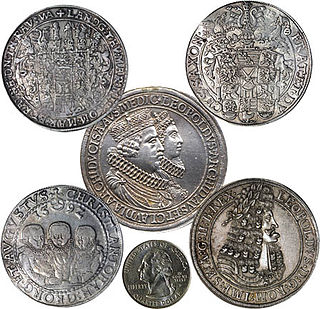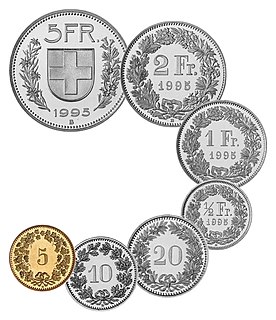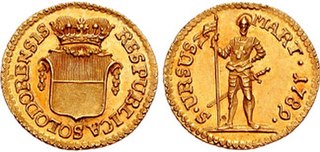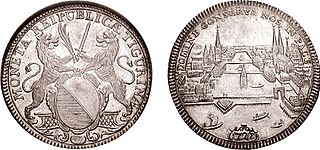Related Research Articles

A thaler is one of the large silver coins minted in the states and territories of the Holy Roman Empire and the Habsburg monarchy during the Early Modern period. A thaler size silver coin has a diameter of about 40 mm and a weight of about 25 to 30 grams. The word is shortened from Joachimsthaler, the original thaler coin minted in Joachimstal, Bohemia, from 1518.

The Swiss franc is the currency and legal tender of Switzerland and Liechtenstein. It is also legal tender in the Italian exclave of Campione d'Italia which is surrounded by Swiss territory. The Swiss National Bank (SNB) issues banknotes and the federal mint Swissmint issues coins.

The Kreuzer, in English usually kreutzer, was a coin and unit of currency in the southern German states prior to the introduction of the German gold mark in 1871/73, and in Austria and Switzerland. After 1760 it was made of copper. In south Germany the kreuzer was typically worth 4 pfennigs and there were 60 kreuzers to a gulden.

The Vereinsthaler was a standard silver coin used in most German states and the Austrian Empire in the years before German unification.

The Conventionstaler or Konventionstaler, was a standard silver coin in Austrian Empire and the southern Germany states of the Holy Roman Empire from the mid-18th to early 19th-centuries. Its most famous example is the Maria Theresa thaler which is still minted today. The Conventionsgulden was equivalent to a 1⁄2Conventionsthaler.

The Reichsthaler, or more specifically the Reichsthaler specie, was a standard thaler silver coin introduced by the Holy Roman Empire in 1566 for use in all German states, minted in various versions for the next 300 years, and containing 25–26 grams fine silver.
The South German Gulden was the currency of the states of southern Germany between 1754 and 1873. These states included Bavaria, Baden, Württemberg, Frankfurt and Hohenzollern. It was divided into 60 kreuzer, with each kreuzer worth 4 pfennig or 8 heller.

The Frank was the currency of the Swiss canton of Aargau between 1798 and 1850. It was subdivided into 10 Batzen, each of 4 Kreuzer or 10 Rappen. It was worth 1⁄4th the French silver écu or 6.67 g fine silver.
The Frank was the currency of the Swiss canton of Appenzell Ausserrhoden between 1798 and 1850. It was subdivided into 10 Batzen, each of 4 Kreuzer or 16 Pfenning. It was worth 1⁄4th the French silver écu or 6.67 g fine silver.

The Basel Thaler was a currency denomination worth 3 livres or 30 batzen used by the Swiss Canton of Basel until 1798. It was used by both the Canton and the Bishopric of Basel.

The Berne Thaler was a coin equivalent to the French silver écu issued by the Swiss canton of Bern. It contained 26.67 g fine silver and was valued at 4 livres.
The Fribourg Gulden was a currency denomination worth 14 Batzen of the Swiss canton of Fribourg until 1798.
The Frank was the currency of the Swiss canton of Fribourg between 1798 and 1850. It was subdivided into 10 Batzen, each of 4 Kreuzer or 10 Rappen. It was worth 1⁄4th the French silver écu or 6.67 g fine silver.
The gulden was the currency of the Swiss canton of Luzern until 1798. It was subdivided into 40 schilling, each of 3 rappen or 6 angster. Coins were also issued denominated in kreuzer and batzen. The French silver écu was equivalent to 3 gulden.
The gulden a currency denomination of Neuchâtel equal to 21 batz until 1850. Neuchâtel's basic currency unit was the livre, divided into 10 batz or 40 kreuzer. The French silver écu was worth 42 batz or 2 gulden. It was replaced by the Swiss franc.
The Frank was the currency of the Swiss canton of St. Gallen between 1798 and 1850. It was subdivided into 10 Batzen, each of 4 Kreuzer or 16 Pfennig. It was worth 1⁄4th the French silver écu or 6.67 g fine silver.
The Frank was the currency of the Swiss canton of Schaffhausen between 1798 and 1850. It was subdivided into 10 Batzen, each of 4 Kreuzer. It was worth 1⁄4th the French silver écu or 6.67 g fine silver.

The Solothurn Thaler was a coin equivalent to the French silver écu issued by the Swiss canton of Solothurn until 1798. It contained 26.67 g fine silver and was valued at 4 livres.
The Frank was the currency of the Swiss canton of Thurgau between 1798 and 1803. It was subdivided into 10 Batzen, each of 4 Kreuzer. It was worth 1⁄4th the French silver écu or 6.67 g fine silver.

The cantons of the Old Swiss Confederacy used a currency system consisting of based on the old unit of the Schilling, with the Schilling divided into 4 Rappen or 12 Haller. The Taler was a large silver coin equivalent to 72 Schilling or 2 Gulden that came into use in the 16th century. The Batzen was an intermediate coin equivalent to 2 Schilling or 1⁄18Gulden.
References
- Krause, Chester L.; Clifford Mishler (1991). Standard Catalog of World Coins: 1801–1991 (18th ed.). Krause Publications. ISBN 0873411501.
